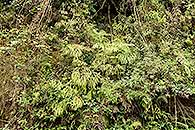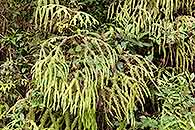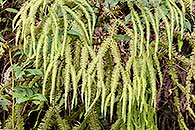Sticherus inflexus Pic.Serm.
Synonyms |
|
|---|---|
Common name |
|
Description |
Fronds climbing, to 3 m long, branched, spaced. Pinnae bent inwards, the outher ones growing higher than the dormant apex of the stipe. Primary pinnae with segments only on one side; secondary pinnae pinnatisect with close and regular segments on both sides. Axes of pinnae thin, those of the same pair slightly different in lenght. Ultimate pinnae more important than the lower ones, with parallel edges and tapering only from above the middle. Ultimate segments linear in outline, 1.5–2 cm long, 2-3 mm wide, apex minutely serrulate near the top, otherwise entire, flat to scantily rolled margins, scales 2-4 mm long, lanceolate to lanceolate-linear in outline. |
Notes | Flora of Tropical East Africa does not recognize this as a seperate species but puts S. inflexus Pic. Serm as a synonym with S. flagellaris (Willd.) ching subsp. tomentosus (Reimers) Verdc. |
Derivation | inflexus: derived from the characteristic direction of the pinnae which are bent inwards, while in the allied species they are bent outwards. |
Habitat | Montane forest, vertical rock in river gorges. |
Distribution worldwide | |
Distribution in Africa |
|
Growth form |
Terrestrial. |
Literature |
|


